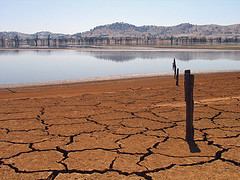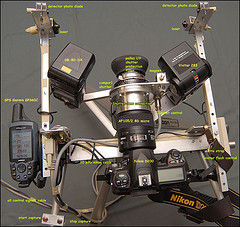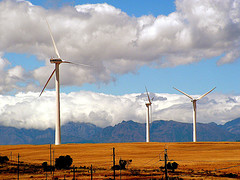April 23rd, 2009 by Eugene Barsky | No Comments »

A recent BBC article mentions research showing that some of the developing world’s largest rivers are drying up because of climate change, threatening water supplies in some of the most populous places on Earth, say scientists.
Researchers from the US-based National Center for Atmospheric Research (NCAR) analysed data combined with computer models to assess flow in 925 rivers — nearly three quarters of the world’s running water supply — between 1948 and 2004.
A third of these had registered a change in flow and most of them — including the Niger in West Africa, the Ganges in South Asia and the Yellow River in China — were dryer.
Rivers are losing water for a variety of possible reasons, say the researchers, including the installation of dams and the use of water for agriculture. But in many cases the decrease in flow is because of climate change, which is altering rainfall patterns and increasing evaporation because of higher temperatures.
The research will be published in the American Meteorological Society’s Journal of Climate next month (15 May) – available for the UBC community in electronic full text.
** Photo by suburbanbloke
Posted in Atmospheric Science, Earth and Ocean Sciences, General Science, Geography, Main, Science - undegraduate classes, Uncategorized | No Comments »
April 17th, 2009 by Kevin Lindstrom | No Comments »
Giving the green light for BC small hydro: independent power producers are taking up the challenge to develop British Columbia’s plentiful supplies of small hydro. Suzanne Pritchard reports. International Water Power & Dam Construction, Dec 2008 v60 i12 p40(2)
“Well known for its mountainous topography and abundant rainfall, the coastal regions of British Columbia can have more than 4m of rainfall per year. In addition, the province’s sheer size, run-off from snow melt and thousands of creek reaches mean it is also ideally suited for run-of-river hydro power. ‘There is phenomenal potential for small hydro here,’ says Mike Wise, vice chair of the hydro committee for the Independent Power Producers Association of British Columbia (IPPBC). ‘The hydro sites are just fantastic.'”
“Beyond British Columbia’s ideal geographic setting for hydro power is the unique ‘green’ design of the run-of-river projects. ‘This design is very different to hydro projects almost anywhere in the world. It is the sole reason why we are judged to have the lowest environmental impact,’ says Steve Davis, president of the IPPBC.
“‘We do not have big storage reservoirs,’ says Davis. ‘In fact, typical headpond is only the size of a soccer field. While most others have short, thick pipes in tall concrete dams, our projects have long, narrow steep pipes and low rubber weirs. Our glaciated hanging valleys and alpine lakes enable us to locate the projects above a natural fish barrier and still get lots of head. So unlike most other hydro projects we are able to avoid directly impacting fish habitat.'”
Want to be familiarize yourself with run of river research both in terms of both the environmental and engineering aspects? What are the issues? Want to separate the hype from the reality?
The following databases will gave you access to international research dealing with run of river power generation:
ASFA and Geobase will give you access to environmental and fisheries related research. Compendex is excellent for the engineering side of run of river power generation.
Submitted by Kevin Lindstrom Liaison Librarian for Earth and Ocean Sciences
Posted in Civil Engineering, Earth and Ocean Sciences, General Science, Geography, Main, Science - undegraduate classes, Uncategorized | No Comments »
March 27th, 2009 by Kevin Lindstrom | No Comments »
Glacier change in western North America: Influences on hydrology, geomorphic hazards and water quality. Moore, R.D.; Fleming, S.W.; Menounos, B.; Wheate, R.; Fountain, A.; Stahl, K.; Holm, K.; Jakob, M. Hydrological Processes Volume 23, issue 1, p 42-61, 2009.
The glaciers of western Canada and the conterminous United States have dominantly retreated since the end of the Little Ice Age (LIA) in the nineteenth century, although average rates of retreat varied from strong in the first-half of the twentieth century, with glaciers stabilizing or even advancing until 1980, and then resuming consistent recession. This retreat has been accompanied by statistically detectable declines in late-summer streamflow from glacier-fed catchments over much of the study area, although there is some geographical variation: over recent decades, glaciers in northwest BC and southwest Yukon have lost mass dominantly by thinning with relatively low rates of terminal retreat, and glacier-fed streams in that region have experienced increasing flows. In many valleys, glacier retreat has produced geomorphic hazards, including outburst floods from moraine-dammed lakes, mass failures from oversteepened valley walls and debris flows generated on moraines. In addition to these hydrologic and geomorphic changes, evidence is presented that glacier retreat will result in higher stream temperatures, possibly transient increases in suspended sediment fluxes and concentrations, and changes in water chemistry. With climate projected to continue warming over the twenty-first century, current trends in hydrology, geomorphology and water quality should continue, with a range of implications for water resources availability and management and hydroecology, particularly for cool and cold-water species such as salmonids.
Volume 23 Issue 1 of the the journal Hydrological Processes is a Special Issue looking at the Hydrologic Effects of a Shrinking Cryosphere.
Submitted by Kevin Lindstrom Liaison Librarian for Earth and Ocean Sciences and Physical Geography.
Posted in Atmospheric Science, Earth and Ocean Sciences, General Science, Geography, Uncategorized | No Comments »
March 25th, 2009 by Eugene Barsky | No Comments »

Educause has released its new report – “7 Things You Should Know About Location-Aware Applications“.
Location-aware applications deliver online content to users based on their physical location. Various technologies employ GPS, cell phone infrastructure, or wireless access points to identify where electronic devices such as mobile phones or laptops are, and users can choose to share that information with location-aware applications. As mobile devices offer greater amounts of data about the environment through which we move, location-aware systems will become increasingly effective at predicting what users would like to know about in the geographical space around them, offering a layer of knowledge superimposed on the physical world that can be accessed for information and convenience.
You can research this topic in many of our online databases, however, IEEE digital Library would be your first source. Try this search in IEEE database – http://tinyurl.com/d6y5aj
** Photo by fotoopa
Posted in Amusing stuff, General Science, Geography, Main, Mathematics, Physics, Science - undegraduate classes | No Comments »
March 13th, 2009 by Kevin Lindstrom | No Comments »
Imagine no facebook, twitter, myspace, email, internet for a entire day?
Shutdown Day is a Global Internet Experiment whose purpose is to get people to think about how their lives have changed with the increasing use of the home computer, and whether or not any good things are being lost because of this.
The idea of Shutdown Day project is simple – just shutdown your computer for one whole day of the year and involve yourself in some other activities: outdoors, nature, sports, fun stuff with friends and family – whatever, just to remind yourself that there still exists a world outside your monitor screen.
For more information, go to Shutdown Day
Submitted by Kevin Lindstrom Science and Engineering Liaison Librarian
Posted in Atmospheric Science, Chemical and Biological Engineering, Chemistry, Civil Engineering, Earth and Ocean Sciences, General Science, Geography, Main, Materials Engineering, Mathematics, Mechanical Engineering, News, Podcasts, Science - undegraduate classes, Statistics, Teaching, Uncategorized, Wood Sciences | No Comments »
February 20th, 2009 by Kevin Lindstrom | No Comments »
There are wide variety of CO2 calculators available on the web. Here’s a short list.
Government of Canada’s ecoACTION Tools and Calculators
EPA Climate Change – Greenhouse Gas Emissions Personal Emissions Calculator
My Carbon Footprint Carbon Calculator
Umweltbundesamt CO2 Rechner
Submitted by Kevin Lindstrom Liaison Librarian for Earth and Ocean Sciences, Chemical and Biological Engineering, Chemistry, Physics and Astronomy, and Geography.
Posted in Atmospheric Science, Chemical and Biological Engineering, Earth and Ocean Sciences, General Science, Geography, Main, Mechanical Engineering, Science - undegraduate classes | No Comments »
February 11th, 2009 by Eugene Barsky | No Comments »

A short article from the New Scientist discusses the Financial Times Energy Conference in London last week. It is a pretty interesting short read.
To see UBC researchers work in this area, you could go to Compendex database (a primary engineering database) – http://toby.library.ubc.ca/resources/infopage.cfm?id=715
and type “sustainable energy” as a topic search and UNIVERSITY OF BRITISH COLUMBIA as “author affiliation”
** Photo by Lollie-Pop
Posted in Atmospheric Science, Chemical and Biological Engineering, Chemistry, Earth and Ocean Sciences, General Science, Geography, Materials Engineering, News, Physics, Science - undegraduate classes, Wood Sciences | No Comments »
February 6th, 2009 by Kevin Lindstrom | No Comments »
The University of British Columbia Library and Springer are delighted to introduce a new Print on Demand feature linked to the Library’s eBook collection: MyCopy powered by SpringerLink.
As a current faculty member of the University of British Columbia, MyCopy allows you to order your own personal print copy of a Springer eBook included in the Library’s collection. The individual copy will be delivered as a printed soft cover version directly to your doorstep. Best of all, it will be available to all patrons for just $24.95 (USD plus GST & PST, including shipping and handling costs).
The University of British Columbia Library is one of the first libraries to introduce the MyCopy service that includes more than 11,000 eBooks out of a total of 30,000 eBooks available on SpringerLink. We invite you to take a look, browse this comprehensive eBook collection and take advantage of the MyCopy service.
If you find an eBook that you would like to use for a course, you can simply copy the URL in the address bar on SpringerLink and add this to your course syllabus. The students can then follow the URL and purchase the eBook directly on http://www.springerlink.com for home delivery.
Below are directions for ordering a MyCopy book for just $24.95 (USD plus GST & PST, including shipping and handling costs)
1. Go to SpringerLink: http://www.springerlink.com
2. Search or browse eBooks in your research area (Available titles will have an orange MyCopy label associated with it.)
3. Click on the eBook or eBook chapter of your interest
4. Click on the MyCopy Logo found underneath the eBook or eBook chapter information, or the “add to shopping cart now” link within the orange box on the right hand column to start the ordering process.
We trust you will find this feature a valuable addition to Springer’s eBook collection. If you have questions, comments, or suggestions, please do not hesitate to contact UBC Librarians Joy Kirchner (joy.kirchner@ubc.ca) and Aleteia Greenwood (aleteia.greenwood@ubc.ca) or Springer at http://www.springerlink.com/feedback.
For a complete list of all Springer Ebooks including MyCopy titles go to the Springer eBooks by Subject Collection page and download the Excel spreadsheet for your discipline. Look for the column that contains the Springerlink openurl and paste this url into your browser.
Submitted by Kevin Lindstrom Liaison Librarian for the Physical and Applied Sciences.
Posted in Atmospheric Science, Chemical and Biological Engineering, Chemistry, Civil Engineering, Earth and Ocean Sciences, General Science, Geography, Main, Materials Engineering, Mathematics, Mechanical Engineering, News, Physics, Science - undegraduate classes, Statistics, Wood Sciences | No Comments »
February 4th, 2009 by Eugene Barsky | No Comments »

This is a quick post to remind you about various standards we have in the SciEng library:
* ASTM up to 2006
* CSA and ANSI standards up to 1995 (How to get those?)
* IEEE Standards: The IEEE Electronic Library provides access to over 1,000 current, revised and superceded standards in the field of electrical and computer engineering. You must be a UBC faculty, student or staff to access these resources. Print standards can be found in the UBC Library catalogue, though coverage varies.
* ISO: We own a number of ISO standards that are listed individually in our library catalogue, mostly from the early 1990s. Try typing ISO and standard? in catalogue search box.
* Open Access Standards (Free):
a.International Telecommunications Union (ITU-T)
b. International Organization for Standardization (ISO) and International Electrotechnical Commission (IEC) Standards. The Standards Council of Canada will grant a license for use of ISO and IEC international standards by recognized Canadian educational institutions in a credit course. Please contact us to learn more about this option.
Please do not hesitate to contact Kevin Lindstrom or Eugene Barsky if you require any additional info!
** Photo by Sifter
Posted in Atmospheric Science, Chemical and Biological Engineering, Chemistry, Civil Engineering, Earth and Ocean Sciences, General Science, Geography, Main, Materials Engineering, Mathematics, Mechanical Engineering, Physics, Science - undegraduate classes, Statistics, Wood Sciences | No Comments »
January 9th, 2009 by Kevin Lindstrom | No Comments »
Professor David McClung from the Department of Geography has published more than forty articles dealing with slab avalanches, avalanche risk, and avalanche forecasting.
Dr. McClung’s most recent publications include
Expanding the snow-climate classification with avalanche-relevant information: initial description of avalanche winter regimes for southwestern Canada. Haegeli, Pascal; McClung, David M. Journal of Glaciology, Volume 53, Number 181, March 2007, pp. 266-276.
Dry snow slab shear fracture speeds McClung, D.M. Geophysical Research Letters, Volume 34, 2007, L10502.
Snow Avalanches as a Non-critical, Punctuated Equilibrium System in Nonlinear Dynamics in Geosciences, Springer Verlag, 2007.
Thinking about heading into the back country? It might be useful to consult the Avalanche Handbook coauthored by David McClung and Peter Schaerer.
Other relevant avalanche websites include:
BC Provincial Emergency Program Avalanche Information
Canadian Avalanche Centre
Canadian Avalanche Foundation
Submitted by Kevin Lindstrom Liaison Librarian for Earth and Ocean Sciences, Physical Geography
Posted in Atmospheric Science, Civil Engineering, Earth and Ocean Sciences, Geography, Main | No Comments »




